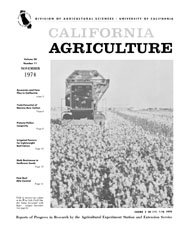


University of California
California Agriculture
|
|||
|
|||

Cover:
Field of narrow-row cotton at the West Side Field Station being harvested with finger - stripper harvester.
November 1974
Volume 28, Number 11 General Information |
|||
|
University of California, 1301 S. 46th St., Bldg. 478 Richmond, CA
|